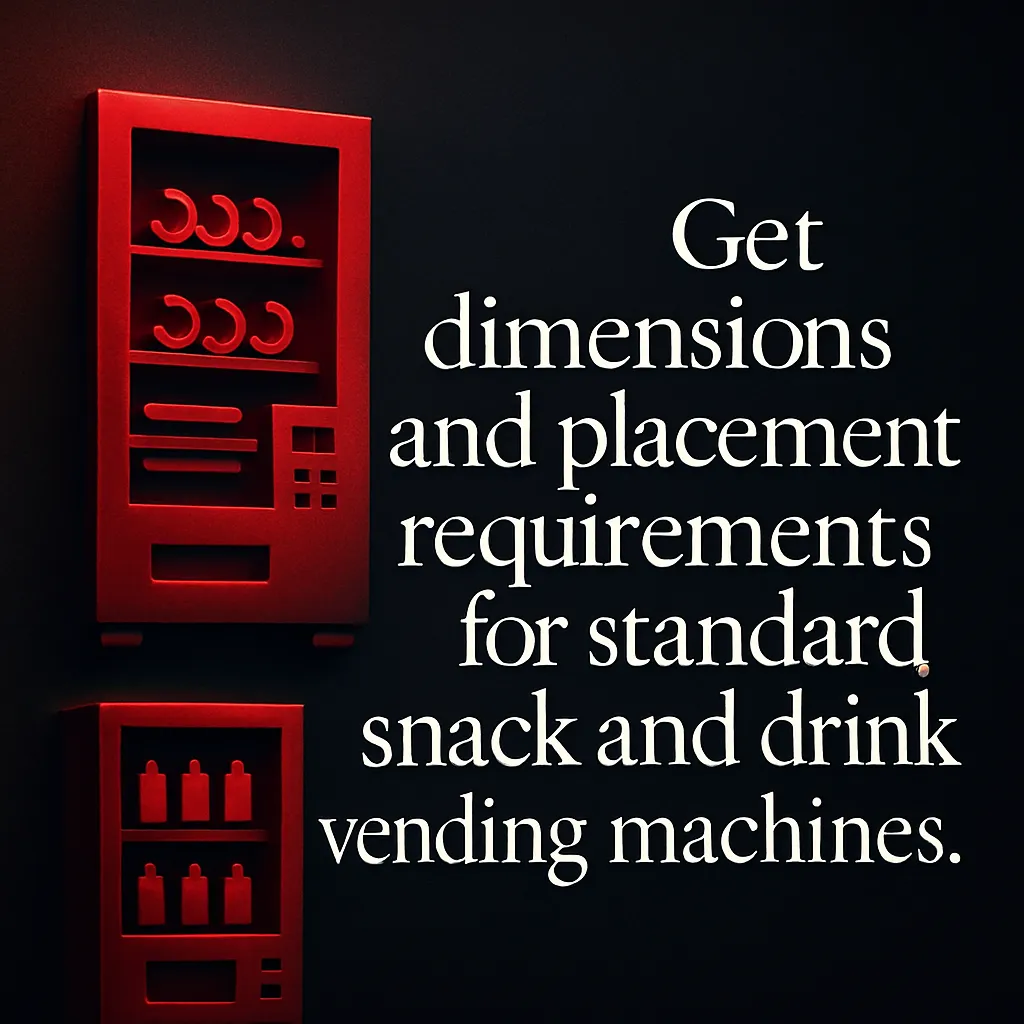How Much Space Does a Vending Machine Need?
Get dimensions and placement requirements for standard snack and drink vending machines.
Back to Vending FAQs ResourcesGet dimensions and placement requirements for standard snack and drink vending machines.
Back to Vending FAQs ResourcesOptimizing the location of your vending machines is key to successful operation. Beyond just the machine's physical size, crucial factors like accessibility, electrical access, and maintenance clearance must be considered to ensure a smooth experience for users and service personnel.
![]() Standard dimensions for snack, drink, and combo machines
Standard dimensions for snack, drink, and combo machines
![]() Essential clearance for ventilation, servicing, and accessibility
Essential clearance for ventilation, servicing, and accessibility
![]() Key considerations like power, flooring, and ADA compliance
Key considerations like power, flooring, and ADA compliance

When considering adding vending machines to your business or facility, understanding the space requirements is crucial for a smooth installation and efficient operation. It's not simply about fitting the machine into an available spot; proper placement ensures accessibility, safety, and ease of maintenance.
Most full-size vending machines, whether for snacks, drinks, or a combination, share similar general dimensions. A typical snack machine is about 72 inches (6 feet) tall, 39 inches (3.25 feet) wide, and 33 inches (2.75 feet) deep. Beverage machines are often similar, but sometimes a couple of inches deeper to accommodate refrigeration. Combo machines, which offer both, optimize internal space to provide variety within a similar footprint to individual units.
The machine itself is only part of the equation. You'll need to account for clear space around it:
Vending machines require a dedicated 110-120V grounded electrical outlet. The placement spot should be near such an outlet, avoiding the use of extension cords, which can be a fire hazard and lead to voltage drops. Discover more about power needs in our guide on Do Vending Machines Need WiFi or Power?.
Flooring is another important factor. Vending machines are heavy, easily weighing 500-800 pounds or more when fully stocked. Ensure the floor can support this weight and is level to prevent tipping and operational issues. Hard, durable surfaces like concrete, tile, or commercial-grade flooring are ideal. For locations that need to consider these factors extensively, insights from resources like How to Install Vending in Your Warehouse can be helpful.
For publicly accessible locations, ADA (Americans with Disabilities Act) compliance is a must. This means ensuring that there's clear floor space for a wheelchair approach (typically 30x48 inches) and that all operative parts (like coin slots, card readers, and selection buttons) are within an accessible reach range, usually between 15-48 inches from the floor. Understanding these guidelines can influence both the machine chosen and its exact placement. More details can be found in our article: Are Vending Machines ADA Compliant?
By carefully considering all these spatial and logistical requirements, you can ensure your vending machines are a convenient and hassle-free asset to your location.
Standard snack machines generally measure around 72 inches tall, 39 inches wide, and 33 inches deep.
Allow at least 2-4 inches behind the machine for proper ventilation and an additional 12-18 inches for service access.
Beverage machines are often comparable in height and width but can be slightly deeper, typically around 33-35 inches, to accommodate refrigeration and larger products.
Combo machines, which offer both snacks and drinks, are usually similar in footprint to individual machines, often around 72x39x33 inches, but maximize product variety within that space.
Yes, vending machines require a dedicated 110-120V grounded outlet. Placement should be near an available power source, avoiding extension cords for safety.
Ensure at least 2-3 feet of clear space in front of the machine to allow the door to open fully for restocking and maintenance.
Yes, slimline or tabletop models are available for locations with limited space, though they offer a reduced product selection.
Vending machines are heavy, so ensure the floor can support the weight. Hard, level surfaces are ideal to prevent tipping and ensure smooth operation.
Yes, ADA guidelines require clear floor space for wheelchair approach and accessible controls, which can influence overall placement and surrounding area needs.
Outdoor machines need similar operational clearances but also require protection from direct weather elements, potentially necessitating a sheltered or covered area.